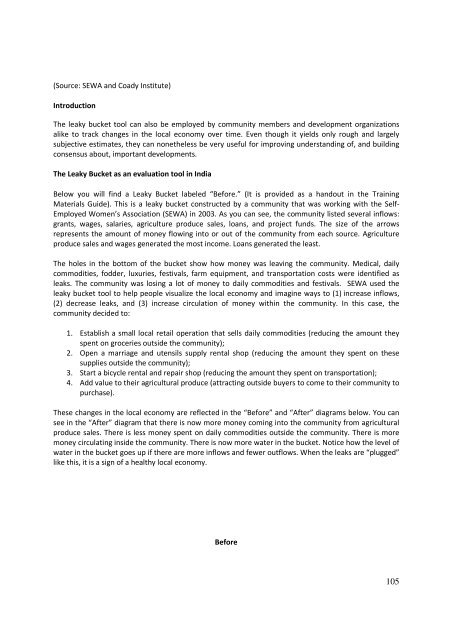ABCD-Training-of-Trainers-Tools-July-2013
ABCD-Training-of-Trainers-Tools-July-2013
ABCD-Training-of-Trainers-Tools-July-2013
You also want an ePaper? Increase the reach of your titles
YUMPU automatically turns print PDFs into web optimized ePapers that Google loves.
(Source: SEWA and Coady Institute)<br />
Introduction<br />
The leaky bucket tool can also be employed by community members and development organizations<br />
alike to track changes in the local economy over time. Even though it yields only rough and largely<br />
subjective estimates, they can nonetheless be very useful for improving understanding <strong>of</strong>, and building<br />
consensus about, important developments.<br />
The Leaky Bucket as an evaluation tool in India<br />
Below you will find a Leaky Bucket labeled “Before.” (It is provided as a handout in the <strong>Training</strong><br />
Materials Guide). This is a leaky bucket constructed by a community that was working with the Self-<br />
Employed Women’s Association (SEWA) in 2003. As you can see, the community listed several inflows:<br />
grants, wages, salaries, agriculture produce sales, loans, and project funds. The size <strong>of</strong> the arrows<br />
represents the amount <strong>of</strong> money flowing into or out <strong>of</strong> the community from each source. Agriculture<br />
produce sales and wages generated the most income. Loans generated the least.<br />
The holes in the bottom <strong>of</strong> the bucket show how money was leaving the community. Medical, daily<br />
commodities, fodder, luxuries, festivals, farm equipment, and transportation costs were identified as<br />
leaks. The community was losing a lot <strong>of</strong> money to daily commodities and festivals. SEWA used the<br />
leaky bucket tool to help people visualize the local economy and imagine ways to (1) increase inflows,<br />
(2) decrease leaks, and (3) increase circulation <strong>of</strong> money within the community. In this case, the<br />
community decided to:<br />
1. Establish a small local retail operation that sells daily commodities (reducing the amount they<br />
spent on groceries outside the community);<br />
2. Open a marriage and utensils supply rental shop (reducing the amount they spent on these<br />
supplies outside the community);<br />
3. Start a bicycle rental and repair shop (reducing the amount they spent on transportation);<br />
4. Add value to their agricultural produce (attracting outside buyers to come to their community to<br />
purchase).<br />
These changes in the local economy are reflected in the “Before” and “After” diagrams below. You can<br />
see in the “After” diagram that there is now more money coming into the community from agricultural<br />
produce sales. There is less money spent on daily commodities outside the community. There is more<br />
money circulating inside the community. There is now more water in the bucket. Notice how the level <strong>of</strong><br />
water in the bucket goes up if there are more inflows and fewer outflows. When the leaks are “plugged”<br />
like this, it is a sign <strong>of</strong> a healthy local economy.<br />
Before<br />
105


